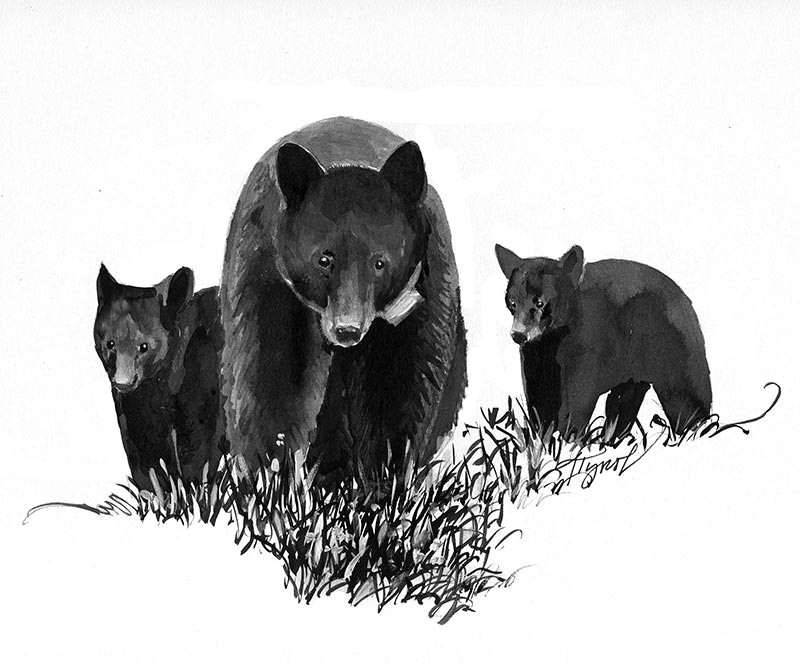
Last week, a black bear in a blaze orange collar showed up in our yard. Two cubs followed close behind. The sow paused to observe the house, then led her cubs up across our field and down into a small stand of apple trees beside the road. There the family feasted on piles of old apples lying in the grass. They appeared to take a methodical approach, working their way from one tree to the next.
Inside our house, the scene was not nearly as calm. There were rushed attempts at photography, foiled by warped window glass. There was my two-year-old son, precariously balanced on the back of a chair by the window, shrieking “BEAR” and occasionally, “SHOES” – his way of demanding to go outside.
We did not go outside. We didn’t take any good photos, either. Eventually a car on the road scared the bears, and they ran up the hill and back into the woods.
Thanks to that orange collar, I knew that the sow was one of Ben Kilham’s research animals. Kilham, a well-known authority on black bears who lives in Lyme, New Hampshire, uses satellite tracking to monitor the movements of several bears in our region. From this data, he has a pretty good sense of how bear travel patterns vary, year to year.
According to Kilham, the sow in our orchard is a four-year-old named “Clarkie.” She was born in Dorchester, New Hampshire, and after being chased out of the natal territory by her mother, settled down near Thetford, Vermont.
Typical of female bears, Clarkie has a home range of just a few square miles. Hers happens to be rich in red oaks – which means that her local food supply is subject to the booms and busts of acorn production. Last year, the oaks produced a heavy crop, so Clarkie had no reason to travel. By this time in autumn, she had bred, fattened up, and gone to den. Pregnant females typically begin hibernation before other bears, Kilham explained, provided that they have succeeded in putting on enough weight.
This autumn has presented more difficult conditions for Clarkie. The acorn crop was meager, and there was intense competition from other nut eaters – a proliferation of rodents that resulted from the previous good mast year. Chipmunks, especially, are “major competitors to black bears,” said Kilham. He noted that beech nut production was also “spotty” this year. Although some sows in heavy beech stands were able to stay home, for Clarkie and many other bears, local beech trees didn’t produce enough mast to meet their nutritional needs.
On top of the acorn scarcity is a second challenge for Clarkie: her status as a first time mother of twins. The sow is working to put on hibernation weight while also still nursing her young, each the approximate size of a Labrador retriever.
All this sounded pretty dire to me, but Kilham seemed to think that the region’s bears in general, and Clarkie in particular, were having a decent year. He described this fall’s superabundant apple crop as a major boon.
While it’s hard to imagine getting fat on apples, Kilham said that bears succeed by digesting a lot of them quickly, instead of eking out every calorie from each piece of fruit. This wham bam approach is why the keen observer may find loose looking bear poop right now, adorned with bright red apple chunks.
Since returning from a foray across the river to Smart’s Mountain, where they fed on beech nuts, Clarkie and her cubs have been on the hunt for apples. “It’s all the bears are eating now,” said Kilham.
In addition to making the rounds among apple trees in Thetford, they have passed through Fairlee, and crossed the interstate up in Bradford. There, the bears lingered for approximately ten hours beside the road. (Kilham explained they were probably waiting to cross until traffic calmed, a behavior he has observed in another one of his research bears.) For the most part, said Kilham, they are only near houses at night, and go unnoticed by humans.
Contemplating Clarkie’s travels, my takeaway is that the value of wildlife corridors – linkage areas that allow wild animals to move from one block of habitat to another – can’t be adequately assessed in any one year. Access routes that are irrelevant to Clarkie and her kin in one year, may be critical to their survival in the next.
When one talks about the benefits of connected habitat, conversations can get wonky, fast. But for me, on a cold afternoon in November, what it came down to was this: three glossy black bears with apple breath, and my human cub at the window, shrieking in delight.


Discussion *